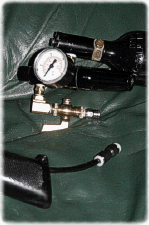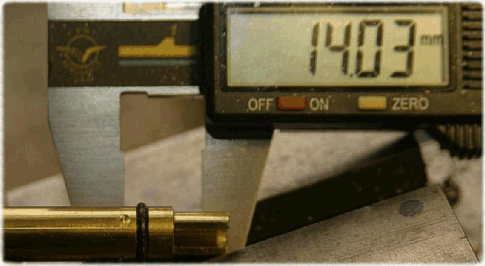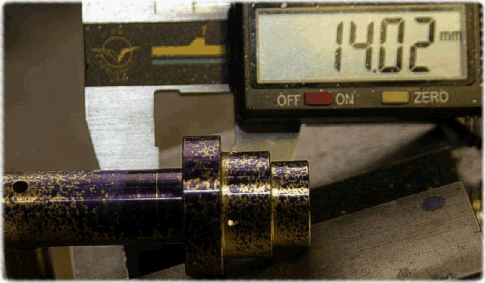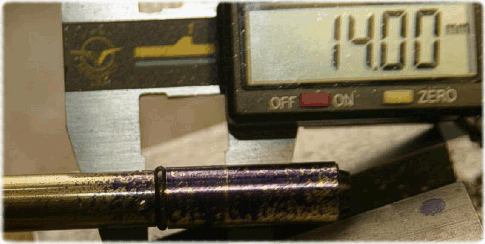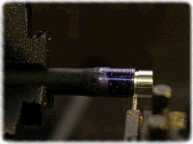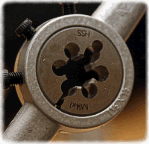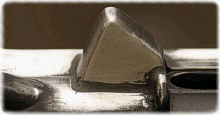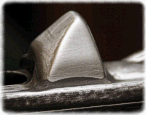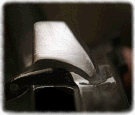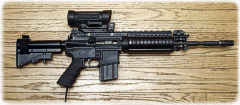Navigation
Introduction: About a year or 2 after I first got into airsoft I had the opportunity to buy a copy of the 2000 edition of “Guns Digest”, a buyers guide for airsoft and model guns and accessories that contains photographs and information (in Japanese) of most of the products that are manufactured in Japan. This publication is essentially “airsoft porn” in that it contains glossy color photographs of many things that you would love to have and caress in the privacy of your own home.
Over the year or so that followed, I owned a Kokusai M16 Patriot pistol and a Youth Engineering MP5A5 and while they were built better than Tokyo Marui guns and were a hell of a lot of fun to shoot, the unavailability of magazines made them extremely impractical as field guns. Both of these pieces ended up being traded away for AEGs. So, fast forward a few years and we find there is renewed interest in classic airsoft guns. Paul Lopansri, who owns and regularly skirmishes with the very Kokusai patriot pistol I used to own, had started the www.classicairsoft.net website. It was here that I eventually found Eric Sefrass’ review of the Sun Project M16A2. http://www.classicairsoft.net/articles/sunpro_m16A1/ . The details provided in the review gave me enough information to know that this gun was something that I really wanted, but was completely unobtainable as they were rarely seen on the used gun market and when they were put up for sale they would fetch upwards of $1000 US! Too rich for my blood. I decided I would use some measurements I took of a Youth Engineering MP5A5 to create my own set of GBB internals for a Systema bodied SR-16 AEG. While I was working on this custom GBB SR-16 I heard rumors that Sun Project M16s were available at various Hong Kong and Taiwan retailers. At first I couldn’t believe it, but after poking around on the Classicairsoft.net forums it was confirmed. Apparently a visit to the USA by Mr. Tawada, the original designer of the Youth Engineering, Sun Project, and Shoei GBB airsoft guns showed him that there was still strong interest in his designs. Upon his return to Japan, he met with the owners of Sun Project and convinced them to renew production of the M16A1 Carbine. Apparently the recent production run was commissioned to test the waters and see if there is indeed a viable market for externally powered airsoft guns globally. Apparently these guns are almost completely sold out, so there may be some hope of another production run being done over the winter/spring of 2004/2005. Care and feeding of these guns is significantly different than that of AEGs. To begin, you will need a power source. There are really only two viable choices in this regard – High Pressure Air (HPA) or Carbon Dioxide (CO2). Both power sources have their pros and cons which are laid out in the table below.
Now you need to get your regulated gas to the gun. Some people choose to use paintball remotes, others choose pneumatic hoses and fitting that are meant for industrial applications. Paintball remotes are simple to source so I will focus on the industrial route instead. Various hose and fitting types are available but the simplest and probably best choice is to go with either ¼” or 6mm hose and “push to connect” fittings. ¼” hose will be easier to find as it is commonly used as air-brake lines in transport trucks and is rated up to 1200PSI. Push to connect fittings are preferred as they allow you to connect and disconnect the hose from your gun without using any special tools. Of course, to assemble everything together you will need some other fittings and thread sealant but the exact list of what you need may vary depending on your regulator configuration. You will have to play it by ear as you get it together. Magazines or more accurately the unavailability of classic airsoft magazines has always been a severe limiting factor in making these guns useable on the field. I have to assume that Mr. Tawada recognized this fact and altered the design of the Sun Project M16 internals to make them compatible with Tokyo Marui magazines. That being said, one must be cautioned that the Sun Project M16s are very sensitive to magazines that feed too slowly or inconsistently. For this reason, G&P mid-cap magazines perform very poorly in the gun, causing frequent mis-feeds and jamming especially in full auto. Similarly, most high capacity magazines aren’t able to keep up with the cycling bolt and will mis-feed as well. The following magazine types are known to perform well in these guns; CA lowcap, TM lowcap, AE hicap, STAR 30rd mags, and the new TM 20rd style 80rd mag. I’m having some success with TM 20rd VN hicaps with occasional mis-feeds in full auto only. Onto the nitty-gritty about the gun itself. Sun Project is calling this an M16A1 Carbine, which is accurate to a degree in that it has an M16A1 upper, M16A1 markings on the lower, a Mattel style telescoping stock and short, ribbed cylindrical hand-guards wrapped around a 16” lightweight barrel. It has an A1 style birdcage flash-hider and a bayonet lug as well. Gordak in Chicago has done extensive research into the distinctive configuration of this gun and determined that it is basically a Colts model M653. This gun wasn’t commonly seen outside of the IDF, so one must assume that Sun Project was just trying to offer some variety rather than pandering to the gun-heads out there otherwise they would have made a few minor changes and released it as a XM177 or other more familiar model. Some enterprising individuals are experimenting with grafting AEG components onto the gun to make it into something like an XM or similar. There is also an outfit in Japan called Plum Project that has done flat-top (and other) modifications to these guns. The fit and finish of the gun is a mixed bag however I think that some of its imperfections are more in keeping with a real-steel M16/AR15 that Tokyo Marui’s idealized vision of what an M16 looks like. What I’m referring to is things like file marks on the receiver, slight imperfections in the finish, and the “gloss” of the pistol grip, hand-guards and stock. Upon very detailed examination of the gun under bright lights, one will notice file marks along the “seam” of the receiver where the assembly technicians at Sun Project filed off flash from the casting process. There are also some light file marks on the rear right of the lower receiver. Some flash is evident around the lips of the magwell, and on some of the smaller parts such as the selector switch and buffer tube collar. Incidentally, the molds used to cast the metal receiver once belonged to JAC. If you ever take a close look at a Sun Project M203 you will also see the JAC name appears on its receiver. The markings on the lower are a tad suspect as well. To begin, the stamping is a fair bit shallower on the left side of the trades than it is on the right. It’s not horrible by any stretch of the imagination. It just isn’t perfect. Also of note, there are no armory marks on the upper receiver and the barrel lacks stamping as well. The forward assist is the A1 teardrop style, and the upper receiver has no brass deflector. There is a serial number on the receiver where you would expect to find it but it is the same on every single gun out there. Each gun does have a unique serial number stamped into the bottom of the trigger guard plate. As I hinted earlier, the plastic furniture is probably a tad on the shiny side for most people’s tastes. That being said, it’s not really any shinier than the furniture I’ve seen on real AR-15s at the shooting range. The grip is an A1 style grip without the finger groove found in later A2s. It is true to the dimensions of the real steel M16A1 grip. The telescoping stock only has two positions but this is easily remedied with some careful work on the drill press. I’m not sure if a real telescoping stock would fit as the one supplied is larger inside than a TM tele-stock. Another note: the buffer tube in this gun is actually functional and contains the recoil spring. Replacement with a real buffer tube is not possible as the threads do not match. Replacement with an AEG buffer tube won’t work at all. I’m not certain how one would go about converting it to a full stock. One thing is certain; an AEG full stock will not fit. One flaw that seems to be very common is a gap of approximately 1mm between the upper and lower receivers. I have a slight peeve about the gun’s packaging. There were no accessories included! No magazine, no cleaning/un-jamming rod, and no sight adjustment tool. In my opinion, if you’re selling a gun with A1 rear sights, you must supply a sight adjusting tool. The selector switch has détentes that are more positive than those on an AEG, but not as stiff as those on a real AR15. Unfortunately, if the gun is set to safe it is possible to pull hard on the trigger and have the selector pop out of safe to semi. For this reason I highly recommend getting a slide valve or similar on/off for your remote so you can safely remove the gun from the gas supply when in a safe zone. The magazine latch is very positive and TM magazines will slide freely in and out of the mag-well when it is depressed. The charging handle is functional and allows you to chamber the first BB before firing a round. The latch on it is a tad stiff however and as a result the charging handle will occasionally fail to return all the way forward. Incidentally, the dust cover is always open on this gun. Some have discussed the possibility of retrofitting a JAC dust cover to gain full dust cover functionality. The receiver pins have spring loaded retaining pins that match the function of those on a real-steel AR-15. You can pull out the rear receiver pin, leaving it latched into the lower receiver by the retaining pin. Once you do this you may field strip the gun exactly like the real thing. Pivot the receiver open on the front receiver pin, and remove the bolt by pulling out the charging handle. Performance wise, the Sun Project does have a couple of issues which affect its playability. The first and probably most significant problem is the hopup. The gun does have a hopup sleeve in it but the sleeve doesn't have anything behind it to provide back pressure against the BB. As a result, the fixed hopup is very weak - so weak that the guns performance is similar to a gun with no hopup. Shots start to drop after about 60 feet or so.
OK, so you've had your SP for a little while and you're finding that the satisfaction derived from the feel of shooting it is offset by anemic hopup and limited range. "Why oh why isn't the hopup adjustable?", you cry. Well, fret no more. As you are aware (no doubt) several users have modified their own SP's to have adjustable hopup. I've taken their pioneering work and made a couple of slight changes to increase stability and reduce the risk of damaging the hopup parts while doing this modification. I have documented the process for those of you who would like to try it yourself. I'd like to thank and give credit to Blitz and Gordak for their pioneering work and tips. Required parts and equipment:
NOTE- Although using a #6/32 set screw should work,
you may want to use a #4/40 set screw instead. Before we get rolling, you'll have to take down the upper receiver, to get complete access to the internals, including the barrel mounting block. Basically you want to get it to this level of disassembly to do this right. Once you get the chamber and barrel out of the barrel mount block, you'll need to remove the barrel from the chamber. Remove the four set screws that hold the barrel in the chamber and carefully remove the barrel from the chamber. On the end of the barrel there is a brass sleeve that actually contains the hopup membrane itself. Carefully remove this brass sleeve and membrane. The membrane should come off with the brass sleeve. (at least, it did on mine) never attempt to force the sleeve or membrane onto the barrel. The membrane is quite fragile. Notice the interior profile of the hopup membrane. So, once I had everything apart I took some measurements. Knowing that I would have to drill and tap the chamber at a point that would coincide with the location of the flat of the hopup membrane, I measured the distance from the barrel mounting set screw marks on the barrel to the cut-out on the end of the barrel where that flat would be located when everything is assembled. Turns out this is very close to 14mm from these set screws. Transferring that measurement to the chamber itself showed that this is also very close to the location of the gap between the front face of the receiver and the rear of the delta-ring on the barrel mounting block. I also marked the brass sleeve at this location as I would have to cut a port to allow the set screw to contact the membrane. Now, once the measurements were made and the course of action decided, I screwed the outer barrel into the chamber block, and mounted the outer barrel and chamber block into the barrel mounting block using the factory installed set screws to ensure correct alignment. *Important Note* - The only parts that should be assembled for this operation are the outer barrel, the chamber block, and the barrel mount block. Perfect rotational alignment of the chamber block in the barrel mount block is critical for this mod to work correctly. You can visually align the sides of the BB inlet nozzle with the receiver pin flange immediately prior to tightening the set screws on the sides of the barrel mount block. I mounted this assembly in a vice and drilled it through the top of the barrel mount block and then the chamber block. It is important to take your time and do this carefully as slight misalignments of the drill can result in significant hooks in your shots once reassembled. I drilled on the midline just forward of the front face of the receiver. Once the holes were drilled (using a 1/8" drill bit) I went on to tap the holes with a #6/32 hand tap. If you tap both the barrel mount block and chamber block simultaneously (as opposed to over-boring the barrel mount block), you can use a 1/2" set screw thus having more threads to bear the stress as well as having the head of the set screw exposed (by about 1/32") outside the receiver of the gun. This makes for easier adjustments as well as greater stability. To cut a port for the setscrew in the brass sleeve, I decided to use a file rather than drilling a hole. This would ensure a lower chance of damaging the membrane, while creating a larger port for the set screw. Here are pics of the modified parts. Please note, this mod requires modification of the dummy gas tube. The following instructions are courtesy of Paul Lopansri, owner of ClassicAirsoft.net
Hi-res pics are here: http://www.pbase.com/agitprop/hopup_mod AEG outer barrel modification: Materials and equipment
I started with a "Commander" brand M4A1 AEG outer barrel. First thing I did was cut off the receiver interface of the M4 barrel just forward of the flange. I used a hacksaw for this. The normal diameter of a TM inner barrel is 8.5mm. The Sun Project has a 10mm barrel. Obviously the outer barrel needs to be bored out. A 13/32 drill is just over 10mm, however 13/32 drill bits that are long enough to bore a barrel are few and far between. My solution? Braze some scrap 1/4" threaded rod onto the back end of a 13/32 drill bit. Since I'm only widening the bore by 1.75mm, the brazing handles the stress with ease. The next step involves shortening the barrel to match the length of the original Sun Project outer barrel. I don't know the exact length. I just laid the barrels beside each other and made a mark. The outer diameter of the receiver end of the SP barrel is 16mm. I had to remove quite a bit of material from the M4A1 barrel to match. Once I had the barrel end to size, I had to cut a profile for the threads. The thread area was turned down to 14mm, with a step down to 12.8mm to provide a non-threaded section to allow for a full seating and adjustability. I made an additional pass at the shoulder to widen the gap after I took the photo below. This gives me more room for adjustments once the barrel is in place on the gun. Cutting threads on a Chinese lathe/mill/drill combo SUCKS!! I tried to cut the threads on the lathe but it was looking pretty bad. I went out and bought a die. Threads are nice and pretty now! I haven’t shown it in the photos but, I used the threaded delta ring that came with the Commander barrel set. I chucked it in the lathe and cut out the threads with a boring bar. The final result! (Now I can use my M7 and my Knight's QD suppressor) This is the brass deflector from a Systema SR-16 upper receiver. My rail is coming from the same receiver. Basically, I cut it out of the Systema receiver, profiled the backside until it matched the SP receiver and cut out a recess for the flange at the back of the ejection port. I sanded away the paint on the SP receiver and affixed the brass deflector using JB weld. I then used some JB weld to fill in the gaps and make a nice bead around the deflector. These pics were taken before sanding to blend the epoxy bead into the receiver. Here are the results after finer sanding.
Equipment and materials.
To start I used the hacksaw to cut off the A1 carry handle. After sawing it off you will need to trim the top of the receiver to the correct thickness. To determine the correct thickness, install the barrel on the receiver, and install the RIS handguards on the gun. You will need to figure out height of the top of the RIS fore-grip compared to the top of the barrel mounting block. Lay a straightedge along the top of the rail and mark where it touches the front of the receiver. In my case this height was 6.2mm. I measured the thickness of my rail (scavenged from a Systema SR-16 receiver. It was 4.1mm, so I used my calipers to scribe a line 2.1mm above the top of the barrel mounting block. In theory, the thickness of the rail and the thickness of the top of the receiver should result in the top of the rail being the same height of the RIS fore-grip. I used a 1,2,3 block and a mill clamp to secure the upper receiver to my milling machine bed. I proceeded to slowly cut away at the front and rear of the receiver to achieve the proper thickness, removing approximately 0.3mm each pass. Once the upper receiver is trimmed to height, you will need to sand the paint off of the top of the receiver and bottom of the rail, as epoxy forms a much stronger bond with metal than it does with paint. I recommend epoxying the rail to the frame as it makes dealing with the screws easier, however I think you could drill, tap and screw it before epoxying if you wish. I epoxied the rail using clamps to secure it while the epoxy set. After setting the epoxy, I sanded and cleaned up the excess epoxy. Four holes were drilled and countersunk and then tapped using the #4/40 tap. Once these structural tasks were finished, I lightly sanded the entire outside surface of the upper receiver and rail to prep for paint. Painting was the final step. I mixed Tamiya flat acrylics to get a color I liked and sprayed them on with an airbrush on my CO2 rig. Here are the results! Hi-res pics are here - http://www.pbase.com/agitprop/flat-top Final cosmetic modifications (bolt-on) Painted the lower and installed the Nitro VO rail sleeve.
Gallery here: http://www.pbase.com/agitprop/completed_mods External links: Links to external sites of interest.
By Tom Goode (aka Agit-Prop) Last modified: Monday, January 24, 2005 10:15 PM Copyright ArniesAirsoft |




